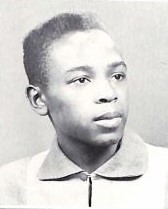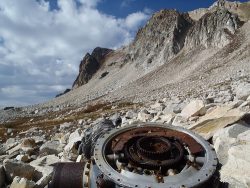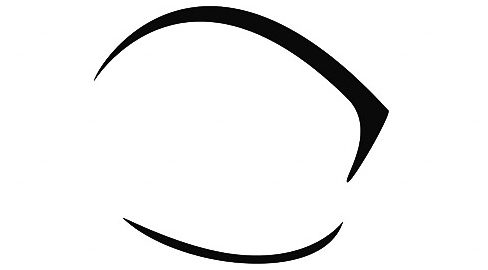It’s the way it is, but it doesn’t have to be, Part 2
Well, they passed a law in ’64
To give those who ain’t got a little more
But it only goes so far
Because the law don’t change another’s mind
When all it sees at the hiring time
Is the line on the color bar, no, no
That’s just the way it is
And some things will never change
That’s just the way it is
That’s just the way it is, it is, it is, it is
–Bruce Hornsby, The Way It Is, 1986
During the academic year 1954-55, an unknown person in the Harding College (now Harding University) admissions office received an application from a young man named Wilbert Neal Whitley who lived in Council Bluffs, Iowa.
It was a slam dunk of an academic CV: good marks in college prep classes, ROTC, and other extracurricular activities such as Junior Red Cross, operetta, and choir.
According to the November 30, 1954 edition of the Council Bluffs Nonpareil, Whitley had even been a finalist in the “Voice of Democracy” contest, entering his recorded essay for judging by the Council Bluffs Jaycees. He was well-rounded, likely “a member of the Lord’s Church,” obviously patriotic, a perfect fit for an up-and-coming, liberal arts school with conservative and Christian values like Harding.

The admissions officer apparently typed out a provisional letter of acceptance. The only remaining requirement before a final stamp of approval was for Wilbert to send in his picture.
It was, at the time, considered a safeguard in the absence of a face-to-face interview. Even if the admissions officer didn’t exactly agree with segregationist policy and its intent, it was not his or her place to say so. It was the rule, no two ways about it, and to question it and risk crossing segregationist and theological racist President George S. Benson was to put one’s job and livelihood in peril.
The admissions officer fed the paper into the rubber platen of the typewriter carriage and started striking the keys, stirring as minor a perturbation of air as one might imagine, like the barely perceptible flutter of butterfly wings.
Wilbert received the letter, but whether or not he perceived its request as a final admission test is anybody’s guess. Perhaps he was high on the fumes of the victory of Brown v. Board of Education of Topeka in 1954 and figured, incorrectly, that all schools, both public and private, had been required to desegregate and would dutifully follow the U.S. Supreme Court’s decision and not put up a fight.
Not being a resident of the South, maybe he assumed things would be as they had been in Iowa where public schools had been officially desegregated since the late 1860s.
It’s doubtful he was trying to make history. He might have surmised he would be one of a handful of African Americans on campus, just like he had been at Thomas Jefferson High School in Council Bluffs. But he was used to that, and he had learned the rules of how to move and behave among his white classmates. He would be understated, nonthreatening, and just work harder to prove himself, like he always had.
Maybe he even thought that a Churches of Christ-affiliated college would accept him because surely they took scripture seriously and would not be influenced by the societal norms of the day. After all, the Apostle Peter had received a revelation and had stated in Acts 10 “But God has shown me that I should not call any man impure or unclean,” and “I now truly understand that God does not show favoritism.”
Wilbert dutifully sent Harding his picture, possibly his senior portrait from the 1955 Thomas Jefferson High School yearbook The Monticello pictured above.
When the admissions office received the photo, distinctions which God had not made were summarily executed, and someone wrote him a letter withdrawing Harding’s provisional acceptance. It is unclear if a decision of this magnitude was made solely by admissions staff or if the decision was run up the flag pole to Dr. Benson himself.
By all accounts, Wilbert was crushed. He pondered his future and his options. It was the way it was, but not how he thought it would be. He had passed many tests during his academic career, but now he had failed the one that would grant him admission to Harding College and untold opportunities–the color bar.
Later in the summer of 1955, Wilbert Whitley ended up in Lufkin, Texas, a Jim Crow municipality in Deep East Texas and the hometown of Larry Bills. It was there that the two young men briefly crossed paths. Why Wilbert was in Lufkin and the reasons his parents appear to have migrated south to Fort Smith, Arkansas that summer are unclear.
Larry Bills had preached for one of the local black congregations before. It was not uncommon for black and white congregations to invite speakers from each other’s congregations, sometimes even “swapping pulpits” on the same Sunday.
They also periodically held joint Gospel meetings. Such cooperative activities in those days were a delicate dance. African American Churches of Christ preachers and their entourages traveled across the country and would often preach before mixed audiences, especially if the meetings were held outside under canopies, such as the old-fashioned “tent revivals.”
Whites in the Churches of Christ felt such efforts would boost the acceptance of the Gospel in their black communities, “save souls,” and make for better citizens–as long as appropriate social distancing was maintained. Most African American preachers knew the score: stick to the plan, don’t “agitate” for civil rights, support both civil and religious segregation, and the patronage and money they received from wealthier, white Churches of Christ would keep flowing.
Someone who knew Larry was a Harding student and also of Wilbert Whitley’s Harding acceptance and rejection letters arranged for the two to meet.
Wilbert told Larry his story. Larry knew it was unjust, but he had also witnessed firsthand the power George Benson wielded and knew of his unbending beliefs on racial matters. He could do nothing other than sympathetically listen to Wilbert’s story and promise to speak up for him if given the chance.
Wilbert may have chosen not to tell Larry at the time, or perhaps he came to his decision after he realized Larry would not be able to help, but sometime during that summer or early fall he decided to enlist in the military. Harding may not have accepted him. but the U.S. Air Force would. Wilbert had participated in ROTC at Thomas Jefferson High and was apparently familiar and comfortable enough with military culture to give it a shot, and his brother, William Whitley, had served with the U.S. Army in the Korean War.
In the wake of President Truman’s Executive Order 9981 on July 26, 1948 which had abolished discrimination in the military “on the basis of race, color, religion, or national origin,” he probably felt a stint in the Air Force, while still a rocky road strewn with major structural, cultural and sociological obstacles, would nonetheless be a smoother path of acceptance and promotion based on his merits and the best chance for upward mobility and a future.
Perhaps with more time and maturity, Harding would catch up and do justice to its Christian name and stated ideals. But for now, college would have to wait for Wilbert Neal Whitley.
By the time United Flight 409 left New York City on October 5, 1955, it was already one hour and 11 minutes late. The plane landed in Chicago, swapped out crews, and proceeded on to Omaha, Nebraska where Wilbert Whitley boarded.
Omaha is just across the Missouri River from Council Bluffs. Perhaps Wilbert had joined-up there and had visited with friends and family in his hometown before starting boot camp. He was now a duly-sworn member of the U.S. Air Force, an Airman Basic (AB), the branch’s lowest rank. By the time Flight 409 ended, there would be a total of 17 Air Force enlistees onboard. Most likely they were en route to either Hill Air Force Base near Salt Lake City or Travis Air Force Base near San Francisco, the flight’s scheduled terminus, to start their Air Force careers.
After landing in Denver and onboarding more passengers, Flight 409 took off again on October 6, 1955 at 6:30 a.m., 83 minutes behind the scheduled departure time. The next scheduled stop was Salt Lake City, a 3-hour flight, and the filed flight plan called for the unpressurized Douglas DC-4 to operate under visual flight rules (VFR) and cruise at an altitude of 10,000 feet over level ground to maximize passenger comfort and pass safely over the continental divide.
Instead, the pilot, like many others from United and other airlines investigators later concluded, decided to take a more southern route over the Medicine Bow Mountains, also known as “The Snowy Range,” most likely in an effort to make up for lost time. When the crew did not check in with flight controllers for their scheduled 8:11 a.m. position report over Rocky River, Wyoming, and after repeated attempts to hail the flight, the Wyoming Air National Guard launched two fighter aircraft to search for the plane.
The pilots concentrated on the two highest peaks in the range. After seeing no sign of the missing plane on Elk Mountain, at 11:40 a.m., one of the pilots and his observer reported a black stain and wreckage on the southwest side of 12,018-foot Medicine Bow Peak.
Although recovery efforts were hampered by bad weather and treacherous terrain, it quickly became clear there were no survivors. It took several days, but eventually volunteers, including fraternity members from the University of Wyoming in Laramie, and teams of experienced alpiners, rescue personnel, and forensic specialists managed to recover and identify the remains of the 66 souls lost in the crash.

According to onboard clocks recovered from the plane, the crash had occurred at 7:26 a.m. Investigators examining the wreckage concluded the plane struck Medicine Bow Peak at a relatively low air speed and in a nose-up attitude, suggesting the pilot’s vision and judgement were perhaps hindered by flying through clouds; as he realized too late the plane was too low, he started an abrupt climb. Flight 409 struck the face of the mountain a mere 50-75 feet short of clearing its peak.
To this day, the black scar on the side of Medicine Bow Peak is still visible, and hikers and climbers, traversing routes and trails unavailable in 1955, occasionally happen upon pieces of wreckage.
Larry learned about the crash along with everyone else. He recalls reading a short story in either the Arkansas Democrat or the Arkansas Gazette (they were separate newspapers at the time) which reported on the death of Wilbert Whitley and mentioned he had been rejected by Harding College because of his race, and in his disappointment, had joined the military.
It is no wonder that the 3rd verse of the Harding Alma Mater stuck in Larry’s craw. “As you can see,” he recently wrote, “the news of integration at Harding had a bittersweet reception in my mind. It came too late for Wilbert.”
For some students, not singing the words, “Harding opens wide her portals, thus inviting all” (which was a bald-faced lie), may have been a means of dissent and a way to supplement the impact of the Statement of Attitude in 1957. But for Larry, it was more than that. It was personal.
Larry eventually sang the 3rd verse alongside Howard Wright and Elijah Anthony, the two African American men who finally cleared the color bar and graduated in 1968, enduring along the way the academic challenges of lifelong disparities in educational opportunities and the harsh and cutting blows that the social gauntlet of a nearly all-white campus could dish out.
The ashes and dust of Wilbert Neal Whitley, a young man whose life was cut short one month prior to his 18th birthday, lay beneath a grave marker in Fort Smith National Cemetery. Still, on that night in October 2018, the absent fourth in their gospel quartet was alive in their minds and singing his own part.
After all those years, Larry Bills had kept his promise to Wilbert and done the only things within his power–he had spoken up for him and remembered his name.
